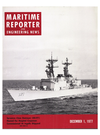
Second Generation LNG Carriers Subject Of Paper Presented At ASNE Pascagoula Section Meeting
The Pascagoula Section of the American Society of Naval Engineers met recently at the TIKI Restaurant in Gautier, Miss.
A cocktail hour preceded a business meeting, which was chaired by A.C. LiCausi, Section chairman.
During the technical session which followed, Alan Nierenberg of the Advanced Programs Group of Avondale Shipyards, Inc., presented his paper on "The Development of Second Generation LNG Carriers for Future Importation Projects." Mr. Nierenberg made the following statements as an introduction to his paper: "The development of a ship design as an integral part of a transportation system is always a challenge to the naval architect and marine engineer. In most cases, the project has been under development for several years before the actual ship design is started, and several constraints already exist to which the ship must be adapted.
"There are several such LNG importation programs which are nearing final regulatory approval and authorization for construction.
These programs will require approximately 21 additional LNG carriers in the 125,000 to 130,000-cubic-meter class to be constructed in the United States. These ships will represent "second generation" LNG carriers in the United States and will include major refinements to the vessel design, cargo containment system, and automation contained aboard the ship.
"Although it is still uncertain which of these programs will proceed and what the final ship requirements will be, this paper will discuss some of the features that have been included in a particular design for the importation of LNG from Indonesia to the U.S. West Coast. Although it is not the prime intent of this paper to discuss the LNG containment systems themselves, it is inevitable that certain portions of the systems will be reviewed due to their impact on the remaining ship design. There is an extensive and continuing evaluation of the containment systems by both the shipyard, prospective owners and independent consultants to insure that timely and efficient production, without unforeseen problems, can take place after contract on these capital intensive vessels.
"As the information contained herein and the vessel design itself is still under further refinement and the subject of negotiations among numerous parties, I regret that it is not possible to address specific details in certain areas."
Other stories from December 1977 issue
Content
- Mar Ad Approves Sale Of Tuna Boats To Foreign Companies page: 4
- Eisenbiegler And Rippy Named Presidents Of Two Sun Subsidiaries page: 6
- James S. Byrn Named President Genstar Marine page: 7
- MarAd Contract Let For Development Of Standardized Carrier page: 7
- Bethlehem Steel Sparrows Point Lays Keel For $78-Million Farrell Lines Containership page: 8
- Navy Commissions Ninth Of 30 Destroyers Being Built By Ingalls Shipbuilding page: 8
- SNAME Completes Boiler Safety Report page: 10
- Raytheon Names Millard Commercial Marine Marketing Manager page: 10
- Charles Murphy Receives Halert C. Shepheard Award For Merchant Marine Safety page: 13
- Program Outlined For Annual Conference On Marine Coatings page: 14
- State Boat Awards Contract To Blount For Offshore Supply Boats page: 15
- MarAd Releases Two-Volume Report Prepared By DeLaval page: 15
- SNAME Philadelphia Section Hears Paper On New Flexible Shipbuilding And Ship Repair Facility page: 16
- ARCTEC Canada Limited Opens Testing Facility And Ice Towing Basin page: 17
- Marine Equipment Suppliers Apply For Title XI To Build Self-Propelled Pipelay Ship page: 18
- Strict Liability And Its Impact On Marine Field Discussed By SNAME No. Calif. Section page: 18
- SNAME Pacific Northwest Section Holds Annual Meeting At Harrison Hot Springs, B.C. page: 20
- New Single Point Monitoring Salinity Control System page: 20
- Worthington Announces Management Positions In Marketing And Sales page: 21
- Rapifax Supplies U.S. Lines With Shipping Industry's First High-Speed Facsimile System page: 22
- Mississippi Marine Begins Offshore Boat Construction page: 23
- Series Production Of Aluminum LNG Spheres page: 24
- ICHCA Conference Set For Helsinki May 26-June 1, 1979 page: 26
- Comet Marine Named Marine Distributor By Crane Packing page: 26
- Oceangoing Towing Guidelines Issued By Det Norske Veritas page: 28
- Bird-Johnson Names Darby Sales Engineer For The Gulf Coast page: 28
- Perko Full Line Catalog Just Released page: 29
- Frankel Elected President Of IMODCO page: 30
- CADCOM, Inc. Appoints F. William Helming page: 30
- Seatrain Shipbuilding Appoints Hellenbrecht Chief Marine Engineer page: 31
- ASNE Reports Details Of Recent Symposium On Combat Systems page: 38
- Combustion Engineering Names Robert Fortier page: 38
- Tenneco's Newport News Industrial Corp. (NNI) Appoints M.R. Eshelman page: 41
- Southeast Shipyard Association Elects Fitzgerald President page: 41
- Belcher Tugs To Use Burmeister & Wain Slow Speed Diesels page: 42
- Three Papers Presented At SNAME California Sections Annual Joint Meeting page: 43
- UNITOR Ships Service Holds Dedication Ceremony To Mark Opening Of Facilities In New Jersey page: 44
- Magnus Maritec Names Three To Sales Posts page: 44
- Zapata In Joint Fishing Venture In Costa Rica page: 45
- Sun Ship Forms New Estimating Department —Brawner Named Manager page: 46
- Barney Evans Opens Public Relations Firm page: 47
- Thistle Field Drilling Started By Santa Fe page: 47
- IMODCO Wins Petrobras Contract To Install SPM At Record Depth page: 47
- Second Generation LNG Carriers Subject Of Paper Presented At ASNE Pascagoula Section Meeting page: 49
- Great Lakes/Great Rivers Section Hears Three Technical Papers During Fall Meeting In Ann Arbor page: 52
- Union Mechling's Application For Aid To Build 58 Barges Approved In Principle By MarAd page: 52

